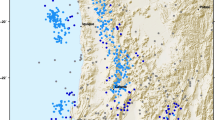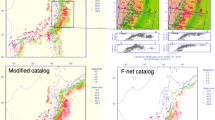Abstract
Generating and editing vector graphics of earthquake catalogs are time consuming when the volume of catalogs is huge; however, most symbols of earthquakes are actually covered by others thus are not visible. We need to condense the catalogs to a limited number by disregarding those invisible symbols to simplify the process. In this paper, we only select the superficial portrait of the whole data volume by ignoring all invisible records. In numerical implementation, we mark one record as active if at least one of its pixels in the virtual bitmap is visible, after judging the superposition relationship between this record and all previous active records; otherwise, we mark this record as inactive and remove it from the catalogs. This approach does not degrade the quality of the final vector graphics, since it can completely separate active records from inactive ones. It can greatly suppress the final size of vector graphics file and significantly reduce the time consumption of drawing, editing, and displaying vector graphics, since the number of active records was condensed to a minimum. In an example of 410,642 earthquake catalogs, only 2577 records (~0.63% the whole catalog) were finally selected as the candidates to be plotted. The run time of our code for selecting these active records spends only ~14 s. The resulted file is only ~2.2 megabyte in size, which is much smaller than that of >100 megabyte when plotting the whole catalog. The run time of plotting active records is about one minute, greatly reduced from >10 h when plotting the whole catalog.







Similar content being viewed by others
References
Agnew DC (2014) Variable star symbols for seismicity plots. Seismol Res Lett 85:775–780
Catmull E (1978) A hidden-surface algorithm with anti-aliasing. ACM Siggraph Comp Graph 12(3):6–11
Clark JH (1976) Hierarchical geometric models for visible surface algorithms. Commun ACM 19(10):547–554
Crow FC (1977) The aliasing problem in computer-generated shaded images. Commun ACM 20(11):799–805
Ekström G, Nettles M, Tsai VC (2006) Seasonality and increasing frequency of Greenland glacial earthquakes. Science 311(5768):1756–1758
Florido E, Asencio-Cortes G, Aznarte JL, Rubio-Escudero C, Martínez-Alvarez F (2018) A novel tree-based algorithm to discover seismic patterns in earthquake catalogs. Comput Geosci 115:96–104
Hao J, Zhang J, Yao Z (2019) Evidence for diurnal periodicity of earthquakes from midnight to daybreak. Natl Sci Rev 6(5):1016–1023
Hearn DD, Baker MP, Carithers W (2014) Computer graphics with open GL, 4th edn. Prentice Hall Press, Upper Saddle River, pp 144–147
Jacobs AM, Kilb D, Kent G (2008) 3-D interdisciplinary visualization: tools for scientific analysis and communication. Seismol Res Lett 79:867–876
Lane JM, Riesenfeld RF (1980) A theoretical development for the computer generation and display of piecewise polynomial surfaces. IEEE T Pattern Anal 2(1):35–46
Nanjo KZ, Ishibe T, Tsuruoka H, Schorlemmer D, Ishigaki Y, Hirata N (2010) Analysis of the completeness magnitude and seismic network coverage of Japan. Bull Seismol Soc Am 100(6):3261–3268
Onur T, GöK R, Abdulnaby W, Mahdi H, Numan NMS, Al-Shukri H, Shakir AM, Chlaib HK, Ameen TH, Abd NA (2017) A comprehensive earthquake catalog for Iraq in terms of moment magnitude. Seismol Res Lett 88(3):798–811
Pantazopoulos I, Tzafestas S (2002) Occlusion culling algorithms: a comprehensive survey, J. Intell Robot Syst 35:123–156
Scitovski S (2018) A density-based clustering algorithm for earthquake zoning. Comput Geosci 110:90–95
Shelly DR, Beroza GC, Ide S (2007) Non-volcanic tremor and low-frequency earthquake swarms. Nature 446(7133):305–307
Sutherland IE, Sproull RF, Schumacker RA (1974) A characterization of ten hidden-surface algorithms. ACM Comput Surv 6(1):1–55
Sydykov A, Sadykova AB, Siylkanova AO (2021) Diurnal periodicity of weak earthquakes in the Zhongar North Tian Shan region. Surv Geophys 42:21–41
Tinevez J (2012) Circle pixel coordinates using mid-point algorithm. https://www.mathworks.com/matlabcentral/fileexchange/33844-circle-pixel-coordinates-using-mid-point-algorithm. Accessed 10 Feb 2020
Wang W, Shearer PM (2015) No clear evidence for localized tidal periodicities in earthquakes in the Central Japan region. J Geophys Res Solid Earth 120(9):6317–6328
Wang W, Shearer PM, Vidale JE, Xu X, Trugman DT, Fialko Y (2022) Tidal modulation of seismicity at the Coso geothermal field, earth planet. Sci Lett 579:117335
Wernecke J (2009) The KML handbook: geographic visualization for the web. Addison-Wesley, Upper Saddle River
Woessner J, Wiemer S (2005) Assessing the quality of earthquake catalogues: estimating the magnitude of completeness and its uncertainty. Bull Seismol Soc Am 95(2):684–698
Yano TE, Takeda T, Matsubara M, Shiomi K (2017) Japan unified hIgh-resolution relocated catalog for earthquakes (JUICE): crustal seismicity beneath the Japanese Islands. Tectonophysics 702:19–28
Yoon CE, O’Reilly O, Bergen KJ, Beroza GC (2015) Earthquake detection through computationally efficient similarity search. Sci Adv 1(11):e1501057
Zhuang J, Ogata Y, Vere-Jones D (2002) Stochastic declustering of space-time earthquake occurrences. J Am Stat Assoc 97(458):369–380
Zhuang J, Ogata Y, Wang T (2017) Data completeness of the Kumamoto earthquake sequence in the JMA catalog and its influence on the estimation of the ETAS parameters. Earth Planet Space 69:1–12
Acknowledgments
We are grateful to Duncan Agnew for his valuable suggestions on rewriting the manuscript. This research was supported by the National Natural Science Foundation of China (41941002) and the Key Research Program of the Chinese Academy of Sciences (ZDBS-SSW-TLC00104). We thank the Supercomputing Laboratory of IGGCAS for providing computing resources. JZ thanks the Foundation for Excellent Member of the Youth Innovation Promotion Association, Chinese Academy of Sciences (2016).
Author information
Authors and Affiliations
Corresponding author
Additional information
Communicated by: H. Babaie
Publisher’s note
Springer Nature remains neutral with regard to jurisdictional claims in published maps and institutional affiliations.
Highlight
• We plot vector graphics of massive earthquake catalogs using occlusion culling.
• We only show the superficial portrait of the data by ignoring invisible records.
• This approach does not degrade the quality of final vector graphics.
• It also greatly reduces figure sizes and the wait time of drawing and editing plots.
Rights and permissions
About this article
Cite this article
Wang, S., Zhang, J. Merging plot of massive earthquake catalogs using the minimum number of active records. Earth Sci Inform 15, 1355–1361 (2022). https://doi.org/10.1007/s12145-022-00793-9
Received:
Accepted:
Published:
Issue Date:
DOI: https://doi.org/10.1007/s12145-022-00793-9




